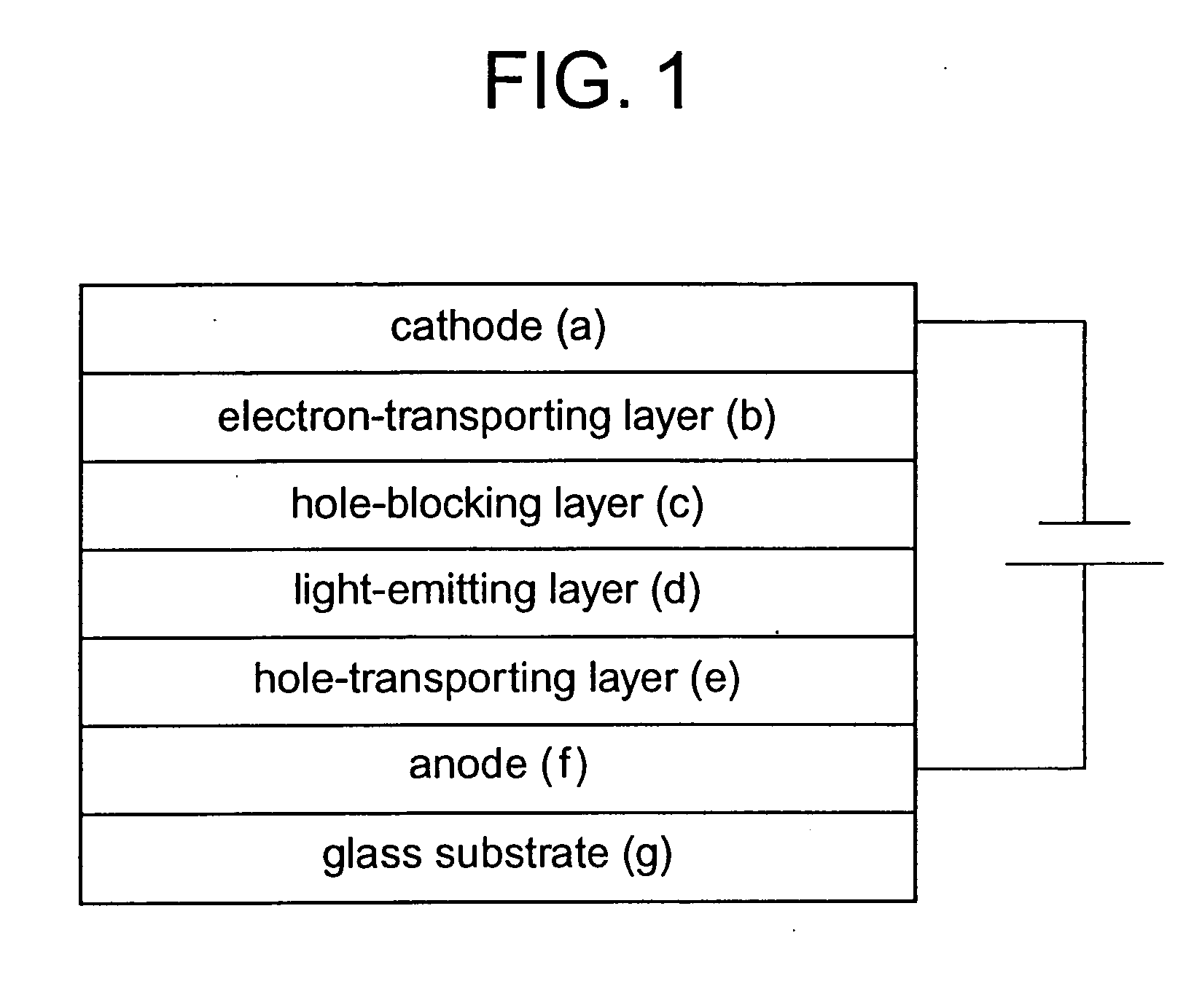Light-emitting device
a light-emitting device and light-emitting technology, applied in the field of light-emitting devices, can solve the problems of not reporting on the application of the compound to light-emitting devices, and still no red or blue phosphorescent substance superior both in colorpurity and luminous efficiency, and achieve superior light-emission characteristics and luminous efficiency. superior
- Summary
- Abstract
- Description
- Claims
- Application Information
AI Technical Summary
Benefits of technology
Problems solved by technology
Method used
Image
Examples
reference example 1
Preparation of Exemplary Compound (2-11): 2,2′-[1,2-phenylene-bis(nitrilomethylidyne)]bisphenol
[0080] Into an ethanol (50 mL) solution of 1,2-phenylenediamine (2.5 g, 23.12 mmol, 1.0 equivalent), salicylaldehyde (5.4 mL, 50.86 mmol, 2.2 equivalents) was added dropwise, and the mixture was stirred under reflux for 3 hours. Crystals in the orange-colored suspension obtainedwere filtered, washedwith ethanol andhexane, and dried by heating under reduced pressure, to give 7.0 g of the exemplary compound (2-11) in a form of orange-colored powder. Yield: 95.7%.
[0081]1H NMR (200 MHz, CDCl3): 6.92 (dt, J=0.6, 7.2 Hz, 2H), 7.04 (d, J=6.4 Hz, 2H), 7.18-7.46 (m, 8H), 8.64 (s, 2H), and 13.04 (s, 2H)
reference example 2
Preparation of Exemplary Compound (2-14): 2,2′-[1,2-phenylene-bis(nitrilomethylidyne)]bis(4-tert-butylphenol)
[0082] To an ethanol (5 mL) solution of 1,2-phenylenediamine (276 mg, 2.55 mmol, 1.0 equivalent), an ethanol (5 mL) solution of 5-tert-butylsalicylaldehyde (1.00 g, 5.61 mmol, 2.2 equivalents) was added dropwise, and the mixture was stirred under reflux for 8 hours. Crystals were filtered from the orange-colored suspension obtained, washed with ethanol and hexane, and dried by heating under reduced pressure, to give 670 mg of the exemplary compound (2-14) in a form of orange-coloredpowder. Yield: 61.3%.
[0083]1H NMR (200 MHz, CDCl3): 1.32 (s, 18H), 6.99 (d, J=8.6 Hz, 2H), 7.15-7.48 (m, 8H), 8.64 (s, 2H), and 12.84 (s, 2H).
reference example 3
Preparation of Exemplary Compound (2-15): 2,2′-[1,2-phenylene-bis(nitrilomethylidyne)]bis(4,6-di-tert-butylphenol)
[0084] To a mixture of 1,2-phenylenediamine (1.47 g, 13.58 mmol, 1.0 equivalent) and 3,5-di-tert-butylsalicylaldehyde (7.00 g, 29.87 mmol, 2.2 equivalents), ethanol (100 mL) was added, and the mixture was stirred under reflux for 40 hours. Crystals were filtered from the yellow orange-colored suspension obtained and dried by heating under reduced pressure, to give 5.90 g of the exemplary compound (2-15) in a form of yellow powder. The filtrate was concentrated to 20 mL and then stirred additionally under reflux for 48 hours to obtain yellow orange-colored suspension. Crystals were filtered from the yellow orange-colored suspension obtained and dried by heating under reduced pressure, to give still more 1.20 g of the exemplary compound (2-15) in a form of yellow powder. Total yield: 96.6%.
[0085]1H NMR (500 MHz, CD2Cl2): 1.32 (s, 18H), 1.42 (s, 18H), 7.26 (d, J=2.4 Hz, ...
PUM
| Property | Measurement | Unit |
|---|---|---|
| external quantum efficiency | aaaaa | aaaaa |
| external quantum efficiency | aaaaa | aaaaa |
| external quantum efficiency | aaaaa | aaaaa |
Abstract
Description
Claims
Application Information
 Login to View More
Login to View More - R&D
- Intellectual Property
- Life Sciences
- Materials
- Tech Scout
- Unparalleled Data Quality
- Higher Quality Content
- 60% Fewer Hallucinations
Browse by: Latest US Patents, China's latest patents, Technical Efficacy Thesaurus, Application Domain, Technology Topic, Popular Technical Reports.
© 2025 PatSnap. All rights reserved.Legal|Privacy policy|Modern Slavery Act Transparency Statement|Sitemap|About US| Contact US: help@patsnap.com



